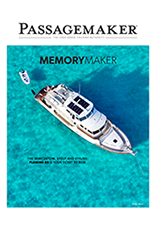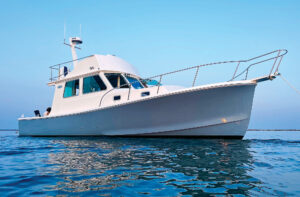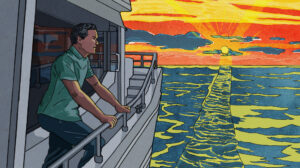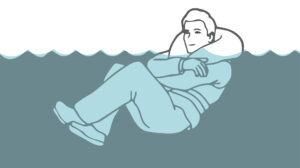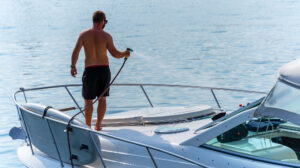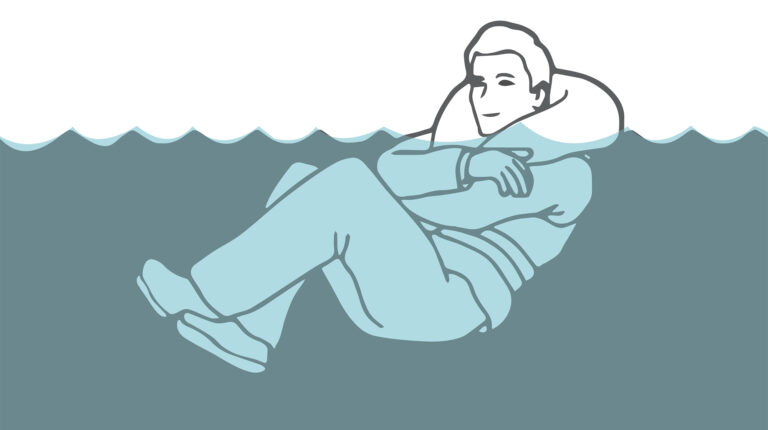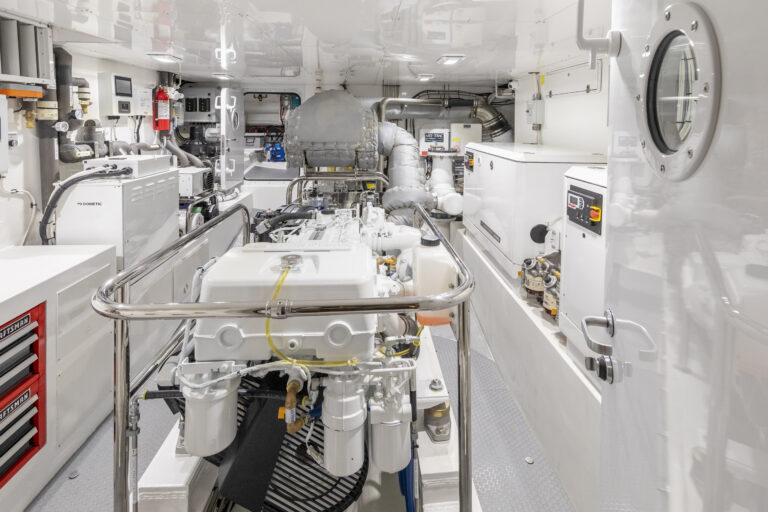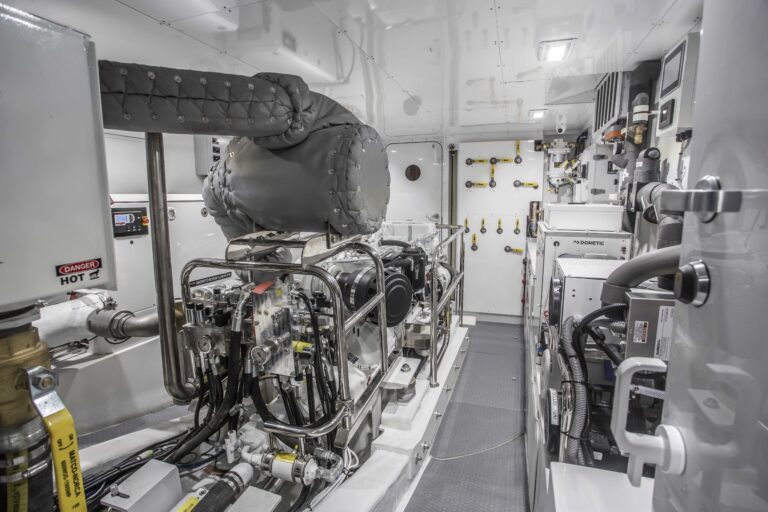One weekend in Hingham, Massachusetts, while I was conversing with some salty dogs in their cockpits, an ancient fellow came wavering down the floating docks carting a pile of provisions. We gave him a hard time, as dock etiquette required, and he informed us that “She’s ready! Two years with a wrench and a brush, and by God, she’s finally ready! I told you I would do it! I’m off to South America, boys!”
“Well, you just give me a holler on channel 71 when you break down at marker number two, and I’ll tow ya back,” a fisherman said while hosing down his skiff.
We all chuckled as the old fellow kept on down the dock. “What’s that all about?” I asked the guys. “Is he crazy or just joking around?”
I was a young family man at the time, too busy and stretched to afford more than an old skiff to poke around the harbor in.
“Oh, no, he’s not crazy or joking,” one of them answered. “He patched up a big old trawler. Been at it for a while. I guess he’s ready to hoist his anchor.”
“To South America?” I asked in disbelief.
“Well, somewhere down there. It’ll take him a year, going about seven knots, but he’s got a right good little diesel that’ll get him there, if he feeds her oil.”
Not wanting to reveal my ignorance before those guys—most of them divorced from wives grown sick of playing second fiddle to a boat—I wandered off down the dock and spied on that ancient mariner to see what he was about. He was crabbing up and down a ladder, loading up the round-bellied boat with a high freeboard and a big wheelhouse. She was as pretty as a toy boat, and named Driftwood. She looked like a safe haven on the sea, as salty as a shaker, built to go more than 3,000 miles at a fast sailboat’s pace on a single tank of fuel. She also looked roomy and seaworthy.
The prospect of one day casting off as captain of such a ship was forever planted in my heart.
“Have a good trip!” I hollered as I waved up to him.
“You betcha!” he hollered back from his foredeck. “This here’s the cheapest waterfront real estate there is, wherever you care to be!”
He resumed making ready for sea as if he owned a great secret, and perhaps he did. The next time I visited the dock, he was gone.
Boats have long been like magnets to me. On our first childhood camping trip to Papoose Pond in Maine, my siblings swam while I begged Mom to please, please rent me a boat. She gave in and rented me a rowboat for an hour. I paddled in circles under her watchful eye as I worked on proving that I was capable enough to survive. Then, she rented it for a week. It was a gift beyond any dream.
In my school years, I tagged along whenever I could with my best friend, “Mud,” to his summer cottage on Lake Winnipesaukee, longing to one day be worthy of helming his family’s elegant mahogany lake boat. In college, I had a joyous three-day sail off the Maine coast with Mud on his dad’s sailing yacht in good winds, and longed to be on the sea ever after.
When my kids were old enough for school, I bought the first floating object I could afford: Redwing, a 26-foot wooden fisherman’s sailboat built in 1908 that was rotting in a yard in Marblehead, Massachusetts. Mud and I spent that spring sanding, caulking, painting and sometimes duct-taping Redwing, recruiting my 5-year-old son, Ben, for help. We launched that heavy old girl with a bottle of cheap wine that wouldn’t break on her tender bow. She floated after we pumped her out a few times. We took her to sea equipped with an oar-handle tiller, a fogged-over compass, a paper chart with a pencil stub, and a whistle tied to a life jacket. As I hauled up the mainsail, I was happier than the owner of a new 100-foot yacht. All that summer, we crisscrossed Massachusetts Bay on her, a little wet, but happy as clams, as Mud would say.
Family and career kept me ashore until I had enough money to buy a used 40-foot sailboat in ’94. I kept her in Connecticut, gunkholing around Long Island Sound and cruising her up the New England coast to Bar Harbor, Maine, for two adventurous weeks each year. Boating was admittedly a spare-time passion during my busiest time of life, but it was much needed—especially the timeless night watches crossing the Gulf of Maine. Reaching along on a 10-knot breeze, resting my head on the cockpit coaming just inches from the water with my foot perched on the helm, I lay enchanted by the water’s gentle lift on rhythmic swells beneath a carpet of stars. There’s nothing like sailing overnight across the Gulf of Maine. If you hum and keep your eyes open, a dolphin will surface by your cheek with a smiling wink that you won’t soon forget.
My day job had become all-consuming, and nature is indifferent to busy agendas. At one point, I rushed a homeward-bound passage and got caught in a dangerous lightning storm. After that, I sold the sailboat and focused on my work. The sea beckoned, of course, but I put her aside for my obligations.
It was 20 years before I could think about yachting again. At 65, I had retirement knocking at my door. I had a great marriage, five wonderful kids and a sprinkling of healthy grandkids, invaluable lifelong friends and enough funds to get along. When my mother died, leaving me money I hadn’t expected, I thought about that vacation when had she had rented me that rowboat. I remembered, too, the old man’s trawler Driftwood, and I decided it was time to look into owning one.
I had in mind a used 48-foot trawler at around $125,000. With the blessing of my patient, adventurous wife, Rosy, I enlisted the help of Randy Altemus of Brewer Yacht Sales to help me find one. We looked for months, but each time, Randy found some fatal flaw: poor maintenance, the wrong layout, inevitable repair costs or poor performance at sea trial. Just as I was beginning to lose hope in finding something I could afford, he called me about a trawler that was below my size requirement and was located out in the Midwest. I had strong doubts about her being only 43 feet long, but it wasn’t in Randy’s interest to sell me a remotely located boat, so I listened.

He said that Lazy W was built in Taiwan in ’85 by the best designer there was, Ed Monk Jr., and that her pedigree, seakeeping abilities, fuel economy and layout could compete with any premier-brand 48-footer, only at a much lower price. I became interested enough to board a plane to Michigan.
I had seen the old Driftwood back in 1985, the same year Lazy W was made, and Lazy W was the same idea, only fully realized. She was heavily built and roomy, but most of all she was gorgeous, inside and out. A yacht with two staterooms, two heads, made with handlaid teak and heavy fiberglass, with a full galley and a spacious, homey salon with a varnished helm below. She had an aft deck with a wet bar where four people could hang out comfortably. I offered the asking price; she was too perfect to mess with, and worth every penny.
The question had evolved from, Can I afford this boat? to Am I worthy of this boat? I imagined the feeling of being on her spacious flybridge in the captain’s chair, with a towering view of her proud bow plowing the glistening sea beneath. I envisioned docking her as handily as a lobsterman, navigating with a knowing eye to the weather while the good ship Lazy W purred along on her journey to exotic ports where we enjoyed sunset cocktails dockside.
I bought her.

It had been years since I’d handled my former sailboat, and I had never so much as taken a ride in a motoryacht. I searched for everything I could find about motoryachts in print and online, making lists and plans for how to handle, manage and navigate her from the Midwest to the Atlantic, but it was no use. I realized that I was afraid. I couldn’t just step onto Lazy W and take over. I needed experienced help.
Randy recommended a delivery captain, Stanley “Capt. Bulldog” Thal, in Greenwich, Connecticut. According to Randy, he “always delivered a boat better than he found it.” When Capt. Bulldog and I discussed his fee, I spilled the beans: I wanted to come along as crew, to learn whatever I could from him.
Delivery captains rarely want the owner along for the ride. Owners are by definition a pain in the neck: immune to orders, ultimately in charge and a number of other grievances. I understood all of that, I explained, but I needed this experience as much as I needed the delivery, and I pushed hard for coming along as a knave, a swab, a humble foremast hand “totally at your command, captain.” He took a risk and agreed.

Finally, the long-awaited day came to take possession of Lazy W and cruise her home. We loaded up a rental van with gear, and I drove from Connecticut to Michigan, while Capt. Bulldog put his first mate, Gerry, and me through boot camp. There were absolute rules, and rule number one was “do it my way or do it again.”
“You may think you can tie a clove hitch, but you can tie a clove hitch when I say you can,” he ordered. This was a man who took his job seriously, with every detail of navigation, times, distances, tides, every inch of a course through the Great Lakes, rivers, locks, canals and bridges to the North Atlantic. There were rigid maintenance regimes, watch schedules and unbreakable guidelines for the crew. Capt. Bulldog had a touch of Ahab, I knew, and his politics were not mine, but he was just what I needed. I was senior in years, but I wanted the no-nonsense, hard-core training of a young recruit, and that was what I was going to get.
Capt. Bulldog put us right to work for a day of making ready, and we fired her up and cast off at next dawn—my heart bursting with glee, never to turn my back on boating again. I had accomplished a lifelong goal in buying Lazy W, but I still had a lot to learn before I could call the captain’s chair my own.
As we got underway, Capt. Bulldog informed me that the Great Lakes, because of their expansive yet shallow waters, can kick up dangerous seas. We didn’t get hit hard, but we did endure 4- to 6-foot seas that blustery spring. Lazy W behaved admirably, even with 6-footers at her stern quarter, consistently humming along at 8.3 knots. As the captain and the ship taught me Lazy’s ways, I nestled into a permanent trust in her seaworthiness and focused on my own abilities.

One evening, we were entering the Welland Canal, which connects Lake Erie to Lake Ontario. It’s a huge system of eight locks that drain and successively lower you down a 400-foot drop. Capt. Bulldog told the zealous mate and me to tend the lines that hung from the lock’s rim, to keep the boat in place.
As the first lock drained, we noticed that mate Gerry was levitating off the deck like a marionette.
“What should I do?” he cried out.
“Let go the line,” the captain quipped.
Our three-week voyage from Lake Michigan to the Atlantic was a special adventure through the lakes, rivers, locks and canals of that diverse and history-laden route. Winding along Mark Twain’s Erie Canal and Pete Seeger’s Hudson River, we went down New York’s East River past upper Manhattan and arrived home on Long Island Sound. There, I bade farewell to Capt. Bulldog, grateful for his sound instruction.
Rosy and I booked a seasonal berth in Stamford, Connecticut, where I watched with great affection as my wife turned Lazy W into our home. Rosy has a Mary Poppins finger-snapping ability to reorganize, redecorate and tidy up. I upgraded some gadgets, and we were at last ready to venture out on our own.

We set out on familiar New England routes: up Rhode Island Sound and Buzzards Bay, through Cape Cod Canal and on to Provincetown. From there, we crossed the Gulf of Maine overnight to Norton Island, where I run a residency program for writers and artists, way up by the Bay of Fundy. The weather was fine, and we couldn’t have been happier aboard our new home on the sea. While returning to Stamford, we talked about taking Lazy W down to Florida for the snowbird experience.
I was ready for something new and unknown on our far-ranging little yacht. We had the perfect boat for the Intracoastal Waterway. Once again, I decided that caution was the better part of valor, and asked Capt. Bulldog to rejoin me until I got familiar with the ICW. He agreed. It would be just the two of us, and his same rules applied.
In October, we hung a left at Hell’s Gate along Manhattan’s skyscraper shoreline, cruised past Lady Liberty and headed out onto the open Atlantic for the run south. The wind blew hard off the Jersey Shore, with some impressive 10-foot rollers at the gate to Atlantic City. We carried on to charming Cape May, New Jersey, and then ran outside toward Norfolk, Virginia, finally holing up at Portsmouth, Virginia, beside mile marker number one of the ICW.
There, I experienced a whole new kind of boating, driving down a man-made liquid highway replete with traffic and stop signs for bridges. Capt. Bulldog was in his element, on an apparently well-known path. He knew every turn of “The Ditch” and was met with familiar jibes at every marina.
We were in the South now, and warming up to it in places like North Carolina’s Coinjock Marina Restaurant, with its famous 32-ounce captain’s cut prime rib. We cruised to Belhaven, North Carolina, on the Pungo River, where you can help yourself to a golf cart to drive into town. There were long, haunting stretches of narrow ditch through swamps, and 5-mile-wide banks of wading-pool-depth water where you follow a narrow dredge across. Egrets, pelicans, herons, manatees and dolphins were our escorts. Every marina had a character of its own.

Social life afloat is different from life on land. Everyone is going somewhere, usually in the same general direction, and is wrestling with wind, water, tide, currents and navigation. Sharing information and helping one another is the general etiquette. Cruising is a nature adventure, but it’s also a people adventure. Much of the ICW’s attraction comes from the unlikely parade of characters who are all just messing about in boats. In sharing that passion, they get along in ways that they couldn’t and wouldn’t ashore. A shared love is a powerful thing.
Life afloat, especially during a passage, is a separate existence. The contrast between being on deck or down below can be severe: You are either snug in a hobbit hole or out on the water experiencing nature’s whims. Meals are simple, small and as frequent as your two-hour watch at the wheel. A celebratory dinner crowns most days. Time passes differently; tides, sunrise and sunset rule the hours, and a night watch during a passage is a mysterious, almost dreamlike experience. Sleep comes earlier and is sounder from constant motion in the elements.
Even the sense of sound is different at sea. All noise derives from you and your boat amid the constant shush of wind and water, punctuated by the occasional, haunting cry of a bird. Daylight glares and dances in the water’s reflection on a flat, vast horizon. Nights are dark, revealing no light from civilization. Fog is downright eerie. The total immersion in nature at sea is immediate and constant. On a long journey, it becomes the new normal, and you are disoriented upon returning to life on the hard.

Then, just when you think you’ve got it all figured out, comes the inevitable storm.
Dirty weather had forced us to hole up in Morehead City, North Carolina, for more than a week. Weather reports promised a 36-hour abatement of the relentless winds, and rather than gain one day’s leg on a four-day crawl down The Ditch to Charleston, South Carolina, we agreed with the delivery captains of two large sailboats on our dock to seize this apparent window of opportunity. We would make up two days by running outside, overnight, around the Frying Pan Shoals.
We realized our mistake by degrees. The winds worsened toward nightfall, when we were past the point of no return while steaming offshore to avoid the threatening shoals. The wind gathered to 50-knot gusts, and waves topped 12 feet. We were being thrown about like ice in a shaken martini when Capt. Bulldog slung open the door and came below.
He had notified the U.S Coast Guard of our predicament. The Coast Guard informed him that our two sailboat friends had run farther offshore, were both dismasted and required rescue. We were on our own.
It was my watch, and the helm needed tending. I heaved myself up by the grab rails toward the hatch as my weary captain gave a parting order.
“There’s a marker on our heading as big as a Volkswagen,” he said. “Hit it and we’ll be fish bait.”
I flung myself through the sliding hatch quickly to keep water out, and I hit the deck. A black, wet, howling nightmare engulfed me as I wrapped an elbow around a rail and belly-crawled down the gangway, and then up the steps to the flybridge. The captain’s chair swung like a fly swatter. I inched toward it, poised myself and, on a weightless plunge, lurched and was slammed down into the chair as we mounted the next wave.
I clutched the bottom rails of the chair as Lazy W rolled 40 degrees on a wave that crested over my head. In absolute terror, I reached out and switched off the autopilot and gripped the wheel, nursing the boat onto a more windward course. Her motion became slightly less violent and the chart plotter moved the murderous buoy to windward, so I reset the autopilot and wedged myself into the chair to hang on and keep a sharp eye. Staring at my wet, bleeding and bruised arms, I wondered how many hours I could endure such violent motion in the dark.
What I learned that night was, when gripped by nature’s wrath, you mostly have to just hang in there.
Lazy W’s trustworthy diesels and Monk’s hull got us through it all. Dawn finally broke to calmer seas, and as we sighted the entrance to Charleston Harbor, our adrenaline melted into simple exhaustion. We tied up at the Mega Dock in the historic downtown, and there awoke in me a jubilant, abiding love for the dear Lazy W, henceforth my sister in arms.
My training was now over. Capt. Bulldog flew off to his next delivery. I recruited my friend Mud for the rest of the journey. Sojourns with Mud are always easy. We never have to tell each other what to do, and we are always quietly content to be together on a boat. By the time we arrived in Fort Pierce, Florida, I was at home in the captain’s chair. Rosy flew down to join me and turn Lazy W into our winter vacation home, where we experienced a whole new way to be together.

We have since cruised nearly 10,000 miles up and down the coast in three years. Many a good friend or relative has shared the experience with us aboard, a wonderful gift to be able to offer them.
As for myself, I am content to have earned my place in the captain’s chair on Lazy W, my steady, wandering home on the sea. I like to think that Mom would be happy and proud about that.
